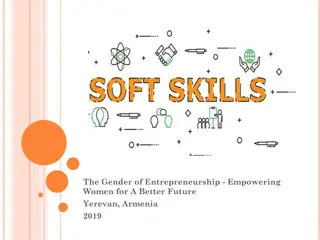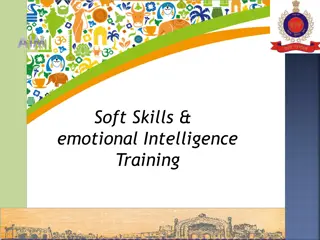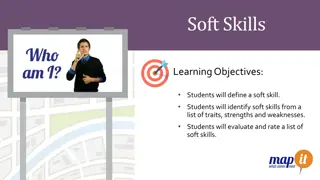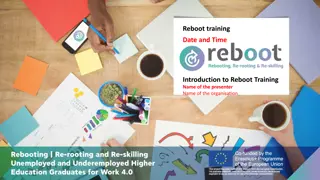Soft Skills Training Program Evaluation at an Indian Garment Firm
This study evaluates the impact of the P.A.C.E. program, focusing on soft skills training at an Indian ready-made garments firm. The research explores the inculcation and productivity-enhancing effects of soft skills in the workplace, questioning the profitability of general training provided by firms. Partnering with a large garment firm in Bangalore, the program offers broad-based training in soft skills, emphasizing the economic benefits of such interventions.
Download Presentation

Please find below an Image/Link to download the presentation.
The content on the website is provided AS IS for your information and personal use only. It may not be sold, licensed, or shared on other websites without obtaining consent from the author.If you encounter any issues during the download, it is possible that the publisher has removed the file from their server.
You are allowed to download the files provided on this website for personal or commercial use, subject to the condition that they are used lawfully. All files are the property of their respective owners.
The content on the website is provided AS IS for your information and personal use only. It may not be sold, licensed, or shared on other websites without obtaining consent from the author.
E N D
Presentation Transcript
THE SKILLS TO PAY THE BILLS: RETURNS TO ON-THE-JOB SOFT SKILLS TRAINING Ach Adhvaryu (Michigan & NBER) Namrata Kala (MIT) Anant Nyshadham (BC & NBER) August 2017 IFPRI
Motivation Skills drive economic growth (Lucas 1988) Large portion of human capital accumulation occurs within the firm (Becker 1964) Does it pay for firms to provide training to workers? Firms returns depend on MP due to training, Pr(retained), and wage
Motivation These, in turn, rely on market structure In competitive labor markets, firms should never pay for general training (Becker 1964) Information/search frictions create MP w > 0 => training profitable for firms (Acemoglu 1997; Acemoglu & Pischke 1998, 1999; Autor 2001)
Soft skills = General Skills The ability to allocate resources (time, money, facilities), interpersonal skills (such as teamwork, teaching others, leadership), the ability to acquire and to use information, the ability to understand systems, and the ability to work well with technology Kautz et al. (2014) Associated with better labor market outcomes (Heckman & Kautz 2012; Deming 2016) Employer surveys indicate they are highly demanded (Cunningham & Villasenor 2016)
Teaching Soft Skills Malleable in early childhood, and most economic benefits of early intervention come through gains in soft skills (Attanasio et al. 2014; Gertler et al. 2014; Grantham-McGregor et al. 1991; Ibarraran et al. 2015) But youth training programs rarely succeed in LICs/MICs (Kluve et al. 2016); true for soft skills training as well, but limited evidence (Groh et al. 2015) Consistent with dynamic complementarity in human capital formation (Aizer & Cunha 2012; Cunha et al. 2010; Heckman & Mosso 2014)
Research Questions Can soft skills be inculcated in the firm context? Are these skills productivity-enhancing? Does it pay for firms to provide general training? We partnered with Shahi Exports, a large Indian ready-made garments firm, to evaluate the P.A.C.E. program
Setting and Program Overview Personal Advancement and Career Enhancement (P.A.C.E.) in 5 factories in Bangalore, India Broad-based training in soft skills Content developed by Gap, Inc. and local NGOs 80 total hours; 2 hours/week; ~11 months Group sessions: ~50 participants/group; female trainers (MSW)
RCT: Design Stage 1 Stage 2 Line randomization Worker randomization Treated (enrolled in P.A.C.E.) = 1087 workers Treatment = 80 lines Spillovers (on treatment line, but not enrolled) = 837 workers 5 factory units 112 production lines 2703 workers (signed up for a P.A.C.E. lottery) Control Control = 32 lines (on control lines) = 779 workers
RCT: Timeline 1 month 11 months 2 months 7 months February 2015 Final month of workplace outcome data collected July 2014 End-line survey May 2014 P.A.C.E. ends July 2013 P.A.C.E. begins June 2013 P.A.C.E. lottery results announced
Data Retention 1000 randomly sampled workers (538 treatment, 462 control) Financial decision-making Awareness of/participation in safety net programs Demand for vocational training Personality Mental health Risk + time preferences Self-assessments relative to peers Daily attendance (+ unexcused absence) Hourly productivity (individual + line) Salary Promotion
Treatment Effect Estimation Dealing with attrition: Dynamic re-weighting of conditional outcomes (e.g., productivity) (Wooldridge 2010) Predict Pr(retention) = T x month-year x baseline characteristics (attendance, schooling, tenure, age, skill level, language) Apply dynamic IPW Check balance using sample remaining at different t Test for diff in retention pdfs across baseline characteristic distribution for T v C
Personality Traits, Mental Health, and Aspirations P.A.C.E. training: - Increased extraversion - Had no impact on mental wellbeing - Increased aspirations regarding children s education
Economic Behaviors P.A.C.E.-trained women were more likely to: - Save for their children s education - Be patient - Avail themselves of gov t pension and healthcare subsidies
Workplace Skill Assessments P.A.C.E.-trained women were more likely to: - Request and complete skill upgrading - Rank themselves above their peers in skill level - Expect a promotion
Retention 5-6pp decrease in turnover duringprogram No impact post-program
Productivity No impact duringprogram 7pp increase in productivity post-program
Task Complexity P.A.C.E. trainees are assigned more complex tasks by supervisors, both during and post program
Salary Salaries increased by 0.5 percent post-program
Net Program RoI Over Time 12% at program completion 256% at end of evaluation period
Mechanism Extraversion , skill development , self-assessment of productivity relative to peers => Productivity But information/search frictions are non-zero (soft skills are hard to signal in the labor market) => Very modest wage increase (MP w > 0 after training) => No long-run retention effects
Alternate mechanisms Reciprocity: substantial spillovers (~80% of direct effects) on productivity and salary Peer effects/social capital: co-workers attended different classes due to production constraints; language and cultural barriers Technical complementarities: estimated complementarities <30%
Thanks Thanks to Gap Inc. & Shahi Exports Funders: PEDL, IGC adhvaryu@umich.edu























